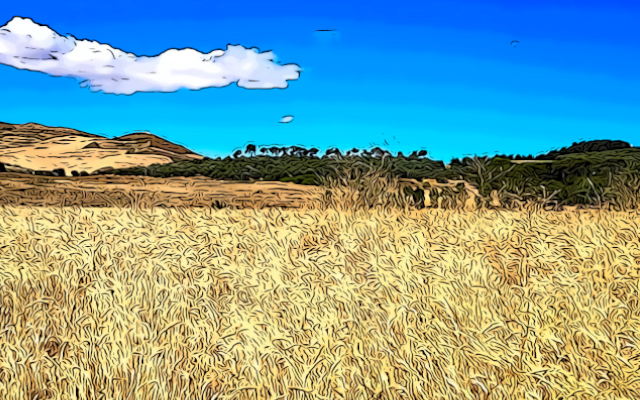A recent scientific study demonstrates the valuable role of crops of
ancient grains
In mitigating the impact of agriculture on climate. Ancient varieties of wheat grown organically, even sequester more carbon than their production cycles emit into the atmosphere. In technical jargon, ‘negative carbon footprint’.
Climate change and carbon footprint of production cycles
Climate change has finally found its way into the mainstream media, thanks to peaceful demonstrations by young Europeans. From squares to economic systems and production chains, designing dutiful containment strategies involves the adoption of appropriate monitoring tools. To measure greenhouse gas emissions to the atmosphere and the effectiveness of interventions.
The carbon footprint
, c.d.
carbon footprint
, is a measure that expresses in terms of ‘CO2 equivalent’ the total greenhouse gas emissions
Associated directly or indirectly with a product, organization, or service. (1)
The Kyoto Protocol lists carbon dioxide (CO2), methane (CH4), nitrous oxide (N2O), hydrofluorocarbons (HFCs), sulfur hexafluoride (SF6) and perfluorocarbons (PFCs) as greenhouse gases. As 11.2 percent of global anthropogenic greenhouse gas (GHGe) emissions are attributed to agricultural practices, it is necessary to implement strategies to reduce them. (2)
Carbon in the atmosphere, the role of agriculture
Agriculture can take a negative but also positive role on the ecosystem due to sustainability in farmland management. That is, where biodiversity-friendly practices are adopted. And ecological functions of agroecosystems. Also reducing theuse of pesticides and synthetic fertilizers.
Soils can be a valuable resource for mitigating climate change. To the extent that they constitute organic carbon stores, they are in fact able to sequester greenhouse gases in the atmosphere. Several scientific studies show that an increase of organic matter in soils to the extent of 1 percent per year for at least 50 years would result in an accumulation of nearly 50 million tons of CO2 in Italy alone. Equal to about 10% of national greenhouse gas emissions. (3)
Organic farming, in particular, can offer significant environmental benefits. (4) Including those related to climate change mitigation and adaptation.. (5)
The grain sector – and legumes in rotation-in Mediterranean soil and climate environments has strategic value, also taking into account the areas invested and the yields obtained. Take decisive action on agronomic techniques in this agricultural sector can therefore be a valuable tool to alleviate the negative effects of climate change.
Ancient grains and climate change, the study
The study ‘
Contribution of old wheat
varieties to climate change mitigation under contrasting managements and rainfed Mediterranean conditions‘, published in the scientific journal ‘Journal of Cleaner Production‘, finds that it is precisely old wheat varieties that represent a promising remedy to mitigate the effects of climate change. (6)
Spanish researchers compared conventional and organic crops of ancient and modern grains under the typical soil and climatic conditions of the Mediterranean area over a three-year period. The results show how the carbon footprint released by old wheat varieties Is significantly lower than modern ones.
The
carbon footprint
of ancient grains, compared to modern grains, is 144 g instead of 263 g of CO2 per kg of grain produced under conventional agriculture. The carbon footprint is even negative, -43 g, in the case of organic crops (compared with the admittedly appreciable 29 g of modern organic grains). That is to say-thanks to reduced energy inputs and their own organic residues-organically grown ancient grains capture more carbon dioxide in the soil than is needed for their entire production cycle.
Organic ancient grains-made with conservation tillage, proper management of agronomic rotations and natural inputs of organic matter-can thus take a leading role in a strategy to combat climate change. And it is curious, an understatement, that the research under review-though published in one of the most prestigious scientific journals in the field-has had no visibility in the generalist media. Always ready, ça va sans dir, to vilely denigrate the organic sector. (7)
Paolo Caruso and Dario Dongo
Bibliography
(1) Source Ministry of Environment
(2) F.N. Tubiello, M. Salvatore, A.F. Ferrara, J. House, S. Federici, S. Rossi, R. Biancalani, R.D. Condor, H. Jacobs, A. Flammini. ‘The contribution of agriculture, forestry and other land use activities to global warming, 1990-2012′. Global Change Biol., 21 (7) (2015), pp. 2655-2660, doi: 10.1111/gcb.12865
(3) With this in mind, the ‘4×1000’ initiative has been proposed to combat climate change by increasing soil organic carbon by a minimum of 0.4 percent annually
(4) Tuomisto H.L., I.D. Hodge, P. Riordan, D.W. Macdonald. ‘Does organic farming reduce environmental impacts? A meta-analysis of European research.’ J. Environ. Manag., 112 (2012), pp. 309-320, doi: 10.1016/j.jenvman.2012.08.018
(5) Scialabba N.E.H., M. Mueller-Lindenlauf. ‘Organic agriculture and climate change.’ Renew. Agric. Food Syst., 25 (2010), pp. 158-169, doi: 10.1017/s1742170510000116
(6) Carranza-Gallego G., G.I. Guzmána, R.García-Ruíza, M.González de Molina, E. Aguilera, (2018). ‘Contribution of old wheat varieties to climate change mitigation under contrasting managements and rainfed Mediterranean conditions.’ Journal of Cleaner Production, Volume 195, September 10, 2018, Pages 111-121. https://doi.org/10.1016/j.jclepro.2018.05.188
(7) Some, almost trivial examples are cited in previous articles
https://www.greatitalianfoodtrade.it/progresso/carne-biologica-abc-vs-fake-news-su-la-stampa
,
https://www.greatitalianfoodtrade.it/progresso/biologico-nessun-animale-in-gabbia
. About misinformation about controls in organic supply chains, comparing with current rules, see also https://www.greatitalianfoodtrade.it/progresso/carne-biologica-abc-vs-fake-news-su-la-stampa









